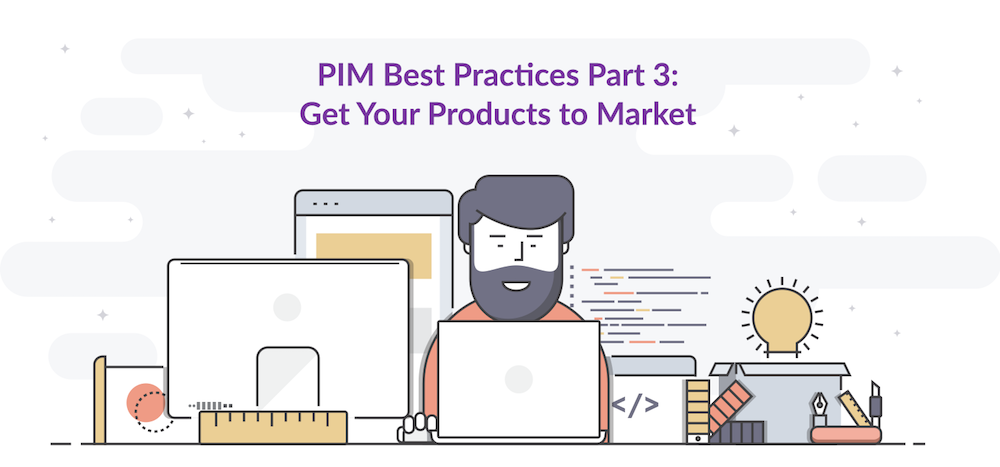This is a multi-part series on the top 10 product information management best practices. This post covers how to get your products to market faster. I...

Keywords
This is a multi-part series on the top 10 product information management best practices. This post covers how to get your products to market faster. If you need to take a step back and start at the beginning, check out part one to learn how to get started with your PIM project or read part two to learn how to gather and enrich your data.
Having complete and accurate product information is crucial to making the sale — but achieving this is often easier said than done. And even so, it’s not quite enough. Verifying the accuracy and completeness of product information before spreading it to all channels is a requirement for providing the right information to the right channel and deliver the omnichannel product experiences customers crave. Modern PIM solutions make this happen.
Here are the PIM best practices that will help you get your products to market faster and ensure they look good across every channel.
When managing information for hundreds, or even thousands, of products, it’s inevitable that human error will introduce inconsistencies into product descriptions.
When listing the dimensions of a picture frame, for example, a user can easily transpose two numbers. When localizing for the United Kingdom, it’s possible to leave the letter “u” out of “color.” Even a simple typo can create a disaster: just a single character separates “Ugg Boots” from “Ugh Boots.”
Errors are unavoidable; what matters is catching them before you publish. Benchmark research conducted by Ventana Research found that only 16% of organizations trusted their product information processes, while better data quality was the top issue motivating improvement in product information for 66% of organizations. A study by Shotfarm, meanwhile, found that 87% of consumers said they’d be unlikely to consider a retailer again if they received incorrect product information.
Product information errors decrease customer confidence in the brand while also decreasing sales and increasing returns.
A PIM solution offers easy-to-use features for verifying the accuracy of individual contributions to product data, as well as the overall completeness of that data. You can define the minimum level of quality and completeness required for a product to be published to a given channel and locale.
The PIM can also track workflow and processes to ensure smooth operation in managing and creating better product data quality. This simplifies the answers to common questions like:
Different sales channels have different requirements for product information. To list a product on Amazon, for example, you need to provide a different set of data than when you’re listing on Wayfair.
There are many contextual variables across channels, from the character count of the product description to mandatory details about the size and materials of the product and even the dimensions and format of the media files. It’s a headache to keep track of, but essential if you want your products to look as enticing as possible when customers click.
When posting products on different sales channels, the number of variables can seem endless.
A key objective for merchandising is ensuring that your products look great across every channel. For example, in Akeneo PIM you can create an export profile within the PIM. This export profile lets marketers export only the data they need, and route it to the desired channel and locale. Marketers can filter export data based on several products and select attributes, families, categories, and identifiers.
Export profiles can be saved for later use, or modified and saved for a different use, so you can export more products as time goes on. These PIM tools work together to save time, reduce errors, and save your team from a ton of aggravating and boring work.
The goal of PIM is to help organizations better manage and distribute product information and create a product experience that ultimately results in increased sales. While these tasks may seem somewhat exclusive to the product or marketing teams, the reality is that using PIM should be an organization-wide collaborative process. Ideally, you have configured your PIM to reflect your organization and how it works. To ensure it evolves with your company and is delivering business value, make sure you track the implementation and success of your PIM project across our organization. What’s more, your product catalog and sales channels are likely to change over time, andyour PIM processes need to support your business growth should change with them.
Here are the typical PIM benefits that you should see in your organization over time:
PIM is the solution to help centralize product information, streamline enrichment and spread contextualized data to your various channels to improve sales within your organization. It helps brands and retailers create the customized omnichannel experiences that customers now expect. Stop using outdated tools to manage product data and revolutionize how you handle product information with PIM.
Ready to see what PIM could do for you? Sign up for a demo.
Want to learn more about the basics of PIM? Download our eBook Product Information Management 101.
Need to start at the beginning? Check out Part 1 and Part 2 of our Best Practices series, or download our eBook Product Information Management 101.


The circular economy presents a powerful opportunity for businesses to align sustainability with profitability by minimizing waste, maximizing...
Read more
Discover what makes Akeneo more than just a workplace. From fostering a culture of care and work-life balance to providing opportunities for growth...
Read more
2024 has been a year to remember for Akeneo. For the third day of PXMas, we’re sharing the stories behind just a few of the prestigious awards...
Read more